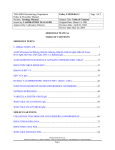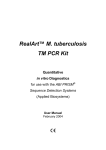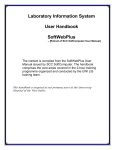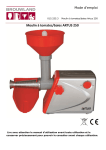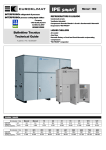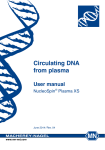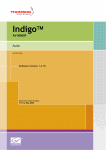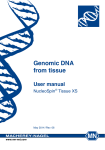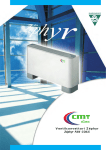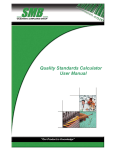Download TML\MSH Microbiology Department Policy & Procedure Manual
Transcript
TML\MSH Microbiology Department Policy & Procedure Manual Section: Serology Manual Issued by: LABORATORY MANAGER Approved by: Laboratory Director Policy # MI/SER/16/v01 Page 1 of 10 Subject Title: Molecular Testing – West Nile Virus RT PCR Original Date: March 14, 2001 Revision Date: October 10, 2003 WEST NILE VIRUS RT PCR I. Introduction West Nile virus (WNV) is a flavivirus belonging to the Japanese Encephalitis group. The primary host is wild birds and the virus is usually transmitted to humans via mosquitoes. Transplants and blood transfusions have also been implicated in its transmission. This assay involves isolating the viral RNA using the Qiagen Viral RNA Kit and amplifying it by RealArtTM WNV Reverse-Transcription (RT)-PCR Kit. The amplification and detection take place simultaneously, continually and in real time in the Roche LightCyclerTM. In real-time PCR, fluorescent dyes are linked to oligonucleotide probes, which bind specifically to the amplified product. Monitoring the level of fluorescence allows the detection of the amplicon. In the Artus WNV assay, two fluorescent dyes are incorporated in the master mix to detect two amplified products: One for the 80 bp WNV amplicon; and the other for the Internal Control (IC). The IC is added to each specimen in the initial step to both control the isolation procedure and to check for PCR inhibition. The LightCyclerTM simultaneously monitors the two different amplicons using two fluorimeter channels. II. Collection and Transport Blood samples for WNV PCR should be collected in EDTA (purple top vacutainer tube). CSF specimens should be collected in a clean, sterile container and sent to the laboratory as soon as possible. If specimens cannot be transported immediately, they should be kept at 4oC. If a delay of more than 6 hours is anticipated, the CSF specimen should be frozen at – 70oC. The EDTA samples should be processed within 6 hours of collection (plasma separated and refrigerated; frozen if delay is more than 6 hours). Allow only one freezethaw cycle. NOTE: Repeated freezing-thawing will reduce test sensitivity and cryoprecipitates may accumulate in the plasma. PROCEDURE MANUAL TORONTO MEDICAL LABORATORIES / MOUNT SINAI HOSPITAL MICROBIOLOGY DEPARTMENT Page 84 TML\MSH Microbiology Department Policy & Procedure Manual Serology Manual Policy # MI/SER/16/v01 Page 2 of 10 III. Procedure A. Worklist Preparation: a. b. Log on to Softmic, Select/type: i. Result ii. Worklist iii. Pagedown to 86 (WNV PCR), iv. Enter v. F12 Pending samples (plasma, serum or CSF) will appear on Worklist. Mark received samples using the F5 key, Type "`" to print Worklist. The numbers on the left column of the Worklist will be used to label the 1.5 mL Eppendoff microcentrifuge tubes and the Qiagen Isolation Columns. LIS Label Printing (if needed for the RNA eluate): c. d. e. B. a. While still in the Worklist, press Enter to go to the Test Screen b. Press F1 to move curser to Demographic field c. Press: / (to Order/Entry) d. Press: No (to confirm editing) e. Press: F9 f. Press: \ (Print Labels) g. Press: No (modify record) h. Select label printer for the LIS label C. Specimens Processing: Specimens should be processed as soon as possible after arriving in virology laboratory. a. EDTA blood: The blood should be centrifuged and an aliquot of about 2 mL plasma frozen unless PCR can be performed immediately. b. CSF: An aliquot (0.2-2 mL)of the CSF should be frozen unless PCR can be performed immediately PROCEDURE MANUAL TORONTO MEDICAL LABORATORIES / MOUNT SINAI HOSPITAL MICROBIOLOGY DEPARTMENT Page 85 TML\MSH Microbiology Department Policy & Procedure Manual Serology Manual Policy # MI/SER/16/v01 Page 3 of 10 After processing, an aliquot of the left-over specimens should be stored frozen at-70°C. D. Materials, Equipments and Facilities: Clean Room with dedicated Biosafety Cabinet (MIBCT4), freezer (MIFTG), gowns and gloves Specimen Preparation area with Biosafety Cabinet and microcentrifuge Detection Room for LightCycler Roche LightCycler programmed for Artus WNV LC PCR Microcentrifuge (MICT14) 1.5 mL microcentrifuge tubes Cooling Block with capillary adaptors pre-cooled to 4oC Variable volume pipettes: 1 to 20 uL 10 to 200 uL 100 to 1000 uL From Qiagen Viral Isolation Kit: Collection Tubes Lysis Buffer AVL (with RNA carrier) – thawed or heated to dissolve crystals formed during refrigeration Spin Columns Wash Buffer 1 (Buffer AW1) – add 125 mL ethanol before use • Wash Buffer 2 (Buffer AW2) – add 160 mL ethanol before use Elution Buffer (Buffer AVE) From: RealArtTM WNV LC RT PCR Kit, Artus: • Quantification Standard no. 3 (102 copies/uL) • Internal Control Ethanol, anhydrous, reagent grade, 96 - 100% GENERAL PRECAUTIONS: • • • • • • • Use only filtered pipette tips Store positive materials (specimens, controls and amplicons) separately from all other reagents and add to reaction mixes in a spatially separated facility (clean room) Clean and specimen pipettes and tips stay separated in their designated rooms Thaw components thoroughly at room temperature Mix components and centrifuge briefly Work quickly in the cooling block Put on fresh gloves and clean gown (colour-coded: blue) when entering the clean room PROCEDURE MANUAL TORONTO MEDICAL LABORATORIES / MOUNT SINAI HOSPITAL MICROBIOLOGY DEPARTMENT Page 86 TML\MSH Microbiology Department Policy & Procedure Manual Serology Manual Policy # MI/SER/16/v01 Page 4 of 10 E. Sample Preparation: Use Specimen Preparation area, work in cabinet with gown and frequent glove change Lysis and Purification Steps: a. For each specimen, Quantification Standard (QS), External Control and Negative Control (H2O) prepare and label two 1.5 mL microcentrifuge tubes (sterilized, RNase-free) with the corresponding number in the Worklist. Label one of them with the lab number (LIS label) also (this microcentrifuge tube will store the eluted RNA, the other will be used for processing and will be discarded). Also, label one QIAamp Spin Column (Qiagen) with the number on the Worklist. Arrange the 2 microcentrifuge tubes and Columns into 3 rows. b. If the Lysis Buffer is stored in the refrigerator and crystals are present, heat to dissolve the crystals. Add 560 uL Lysis Buffer (AVL with RNA carrier) into each of the microcentrifuge tubes in one row (these will contain the waste). c. Add 5 uL WNV Internal Control to each of the microcentrifuge tubes with Buffer AVL. d. Add 140 uL specimen to the Lysis Buffer (Buffer AVL with RNA carrier), vortex for 15 seconds. e. Incubate at Room Temperature (15-25oC) for 10 minutes. f. Centrifuge for 10 seconds at 2000 g to remove drops from the lids. g. Add 560 uL ethanol (96-100%) to the samples, vortex for 15 seconds. Centrifuge for 10 seconds at 2000 g to remove drops from the lids. h. Pipette 630 uL (half the volume) of the mixture (specimen-lysis buffer-ethanol) to the QIAamp spin column (in a 2 mL collection tube), close the cap and centrifuge at 6000g (8000 rpm) for 1 minute. Place the QIAamp spin column into a clean 2 mL collection tube and discard the collection tube containing the filtrate. PROCEDURE MANUAL TORONTO MEDICAL LABORATORIES / MOUNT SINAI HOSPITAL MICROBIOLOGY DEPARTMENT Page 87 TML\MSH Microbiology Department Policy & Procedure Manual Serology Manual Policy # MI/SER/16/v01 Page 5 of 10 i. Repeat Step 7 by pipeting the remaining 630 uL of the mixture to the QIAamp spin column (in a 2 mL collection tube), close the cap and centrifuge at 6000g (8000 rpm) for 1 minute. Place the QIAamp spin column into a clean 2 mL collection tube and discard the collection tube containing the filtrate. j. Open the spin column and add 500 uL of Buffer AW1. Close the cap and centrifuge at 6,000g (8,000 rpm) for 1 minute. k. Open the spin column and add 500 uL of Buffer AW2. Close the cap and centrifuge at full speed (20,000g; 14,000 rpm) for 3 minutes. l. Place the spin column into a clean 2 mL collection tube and discard the collection tube containing the filtrate. Centrifuge at 20,000g for 1 min. Elution Steps: a. Place the spin column in the second clean 1.5 mL microcentrifuge tube with the LIS specimen label. Discard the collection tube containing the filtrate. Open the spin column and add 50 uL of Elution Buffer (Buffer AVE). Close the caps and incubate at room temperature for 1 minute. Centrifuge at 6000g (8000 rpm) for 1 min. Store the eluate at -20oC or –70oC if not able to proceed immediately. PCR Amplification and Detection Procedures: b. In the Clean Room: (Changed to dedicated clean room gown and gloves, work in Cabinet) a. Take out the necessary number of WNV Master Mix vials (12 tests per vial) from the freezer and thoroughly thaw inside the Biosafety Cabinet. b. Place a capillary for each purified sample, QS, external QC and H2O into the capillary adaptor of the Cooling Block (pre-cooled to 4oC). c. Pipette 15 uL Master Mix into the reservoir of each capillary. d. Changed out of dedicated clean room gown PROCEDURE MANUAL TORONTO MEDICAL LABORATORIES / MOUNT SINAI HOSPITAL MICROBIOLOGY DEPARTMENT Page 88 TML\MSH Microbiology Department Policy & Procedure Manual Serology Manual Policy # MI/SER/16/v01 Page 6 of 10 In the Specimen Processing Room: (Changed into specimen room gown) a. Using a separate filter tip each time, carefully pipette 5 uL each of purified sample, QS3, external QC and H2O (already spiked with 0.1 mL internal control per 1 mL H2O) directly into the capillary reservoir. Immediately close the capillary with a lid. b. Load capillary tubes into LightCycler (LC) adaptor and centrifuge at 3000 rpm for 15 seconds in LC centrifuge. Transfer the LC adaptor to the LC instrument. c. Alternatively, if the LC centrifuge is not available, centrifuge the capillary in the adaptors for 10 seconds at 2000 rpm (400g) to transfer the mixture from the reservoir to the capillary, making sure that the engraved numbers on the adaptors correspond to the correct sample. d. Place the adaptors and capillaries back in the Cooling Block and proceed to the LightCycler. In the LightCycler room: a. Turn LightCycler and the computer on b. Click on the LightCycler icon and click "run" c. Select "selftest", skip if already done within 24 hr. or d. Press: OK e. Select: "Run Experimental File" " WNV protocol" f. Type in file name “WNV-run number-year-month-date” g. Select “run” h. Type in the number of samples to run including QS, ext. QC and H2O i. Click “Edit Sample Later” j. Type in the lab numbers; QS; ext. QC (if any) and H2O PROCEDURE MANUAL TORONTO MEDICAL LABORATORIES / MOUNT SINAI HOSPITAL MICROBIOLOGY DEPARTMENT Page 89 TML\MSH Microbiology Department Policy & Procedure Manual Serology Manual Policy # MI/SER/16/v01 Page 7 of 10 k. On the QS row, click the arrow-down button to change its description from “Unknown” to “STD” and enter the number of copies/uL (eg. QS3=100) l. Press “done” m. To Print Results, go to: “FLUORESCENCE” and click • F1 • Quantification • Print Window m. To Print Internal Control, go to: “FLUORESCENCE” and click: • F3/BACK F1 • Print Window PROCEDURE MANUAL TORONTO MEDICAL LABORATORIES / MOUNT SINAI HOSPITAL MICROBIOLOGY DEPARTMENT Page 90 TML\MSH Microbiology Department Policy & Procedure Manual Serology Manual IV. Policy # MI/SER/16/v01 Page 8 of 10 Reporting: Fluorimeter Channel F1 (WNV amplicon) Fluorimeter Channel F3 back F1 (IC amplicon) Interpretations - - Possible PCR inhibitionRepeat assay. If still -ve on both Fluorimeter Channels, report: Indeterminate - + Report: Negative + - + + Preliminary report: Positive Repeat assay to confirm. If still +ve on fluorimeter Channel F1 Report: POSITIVE Preliminary report: Positive Repeat assay to confirm. If still +ve on fluorimeter Channel F1. Report: POSITIVE Positive results for the WNV amplicon (Channel F1) will have the cycle number printed under the Cross Point Column in the chart and the Calculated values will be at least 10 copies/uL (>QS4). The curve will be rising exponentially and levels off to a plateau. The sample must be repeated for confirmation. Internal Control amplicon need not be positive. Indeterminate results may be those with a positive signal for the WNV amplicon (Channel F1) cycle number printed under the Cross Point Column in the chart but the Calculated values are less than 10 copies/uL (<QS4). The curve will be rising at a high cycle number. The sample must be repeated. PROCEDURE MANUAL TORONTO MEDICAL LABORATORIES / MOUNT SINAI HOSPITAL MICROBIOLOGY DEPARTMENT Page 91 TML\MSH Microbiology Department Policy & Procedure Manual Serology Manual Policy # MI/SER/16/v01 Page 9 of 10 Indeterminate results may also be those with no signal for the WNV amplicon (Channel F1) and also no signal for the IC amplicon (Channel F3 back F1), indicating possible PCR inhibition. The test must be repeated. Negative results for the WNV amplicon (Channel F1) will be blank under the Cross Point Column in the chart and the curve will be rather flat. The IC amplicon (Channel F3 back F1) must be positive to be valid. Negative Report: Negative by RT-PCR. This is a research test performed by using RealArt WNV assay, Artus Biotech Inc. Indeterminate Report: Indeterminate by RT-PCR This is a research test performed by using RealArt WNV assay, Artus Biotech Inc. Positive Report: POSITIVE by RT-PCR This is a research test performed by using RealArt WNV assay, Artus Biotech Inc. Phone all Report positive results and inform senior/charge technologist. Record isolate in LIS by F7 as “77wnv”. V. Quality Control • • • Equipment QC: Every six months: Colour Compensation (to compensate interference between different fluorochromes) should be run to update the Colour Compensation File. Reagent QCs: Before every lot change of isolation and/or master mix kit: An External Control (external to Artus Biotech) is used to monitor the isolation, amplification and detection procedures. The result must correspond to expected value supplied by the manufacturer. Before every lot change of master mix kit: All four Quantification Standards (QS 1, 2, 3, and 4) must be run. PROCEDURE MANUAL TORONTO MEDICAL LABORATORIES / MOUNT SINAI HOSPITAL MICROBIOLOGY DEPARTMENT Page 92 TML\MSH Microbiology Department Policy & Procedure Manual Serology Manual Policy # MI/SER/16/v01 Page 10 of 10 Daily QCs: Every run: • Each patient specimen must have an Internal Control (IC) added to monitor both isolation and PCR inhibition. The sample must show a positive reading in either fluorimeter Channel F1 (WNV amplicon) or fluorimeter Channel F3 back F1 (IC amplicon) to be valid (no PCR inhibition). • A Positive Control (eg. Quantification Standard #3) is included and shows a positive reading in fluorimeter Channel F1 (WNV amplicon). • A Negative Control (eg. H2O spiked with IC) is include and shows a negative reading in fluorimeter Channel F1 (WNV amplicon) and a positive reading in fluorimeter Channel F3 back F1 (IC amplicon). Report all failed QCs to senior/charge technologist. VI. References: QIAamp Viral RNA Mini Kit Handbook 01/99, Qiagen RealArtTM WNV LC RT PCR Kit User Manual March 2003, Artus LightCycler, Roche Diagnostics PROCEDURE MANUAL TORONTO MEDICAL LABORATORIES / MOUNT SINAI HOSPITAL MICROBIOLOGY DEPARTMENT Page 93










